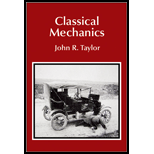
Concept explainers
(a)
The force in the rest frame
(a)
Answer to Problem 15.109P
The force in the rest frame
Explanation of Solution
Consider that two charges are moving in
The force between the charges in its rest frame in
Write the net force between the two charges in
But
Using
Using
Using
Since
Use the above equation in equation (II).
Since
Use the above equation in equation (IV).
Write the equation for net force between the charges in
Conclusion:
Therefore, the force in the rest frame
(b)
The electric field and magnetic field in
(b)
Answer to Problem 15.109P
The electric field in
Explanation of Solution
In
Here,
Write the expression for
Since
Write the expression for
Since
Write the expression for
Since
The net electric field in
Both the charges are moving with the same speed, thus the relative speed of both the charges is zero. Since each charge is stationary they produce zero magnetic field
From transformation equation,
From the above equation
From transformation equation,
From the above equation
From transformation equation,
Since
From transformation equation,
Since
By solving equation (XIV) and (XV), we conclude that
From transformation equation,
Since
From transformation equation,
Since
Use the above equation in equation (XVIII).
Since
Use equation (XXI) in (XX).
The net electric field in
The net magnetic field in
Write the Lorentz force on each charge in
Here,
Use equation (XXIII) and (XXIV) in the above equation.
The electrostatic force is positive thus it is attractive, and the magnetic force is negative thus it is responsive.
When
Conclusion:
Therefore, the electric field in
Want to see more full solutions like this?
Chapter 15 Solutions
Classical Mechanics
 College PhysicsPhysicsISBN:9781305952300Author:Raymond A. Serway, Chris VuillePublisher:Cengage Learning
College PhysicsPhysicsISBN:9781305952300Author:Raymond A. Serway, Chris VuillePublisher:Cengage Learning University Physics (14th Edition)PhysicsISBN:9780133969290Author:Hugh D. Young, Roger A. FreedmanPublisher:PEARSON
University Physics (14th Edition)PhysicsISBN:9780133969290Author:Hugh D. Young, Roger A. FreedmanPublisher:PEARSON Introduction To Quantum MechanicsPhysicsISBN:9781107189638Author:Griffiths, David J., Schroeter, Darrell F.Publisher:Cambridge University Press
Introduction To Quantum MechanicsPhysicsISBN:9781107189638Author:Griffiths, David J., Schroeter, Darrell F.Publisher:Cambridge University Press Physics for Scientists and EngineersPhysicsISBN:9781337553278Author:Raymond A. Serway, John W. JewettPublisher:Cengage Learning
Physics for Scientists and EngineersPhysicsISBN:9781337553278Author:Raymond A. Serway, John W. JewettPublisher:Cengage Learning Lecture- Tutorials for Introductory AstronomyPhysicsISBN:9780321820464Author:Edward E. Prather, Tim P. Slater, Jeff P. Adams, Gina BrissendenPublisher:Addison-Wesley
Lecture- Tutorials for Introductory AstronomyPhysicsISBN:9780321820464Author:Edward E. Prather, Tim P. Slater, Jeff P. Adams, Gina BrissendenPublisher:Addison-Wesley College Physics: A Strategic Approach (4th Editio...PhysicsISBN:9780134609034Author:Randall D. Knight (Professor Emeritus), Brian Jones, Stuart FieldPublisher:PEARSON
College Physics: A Strategic Approach (4th Editio...PhysicsISBN:9780134609034Author:Randall D. Knight (Professor Emeritus), Brian Jones, Stuart FieldPublisher:PEARSON





